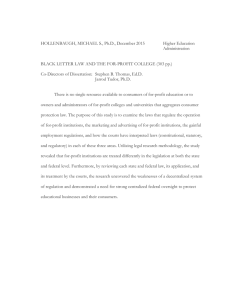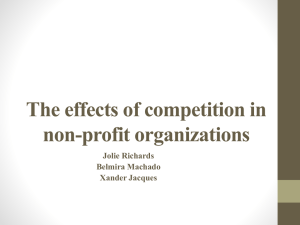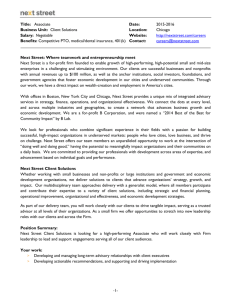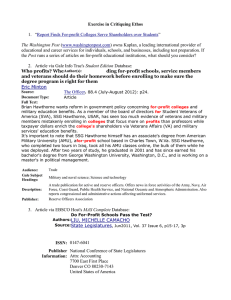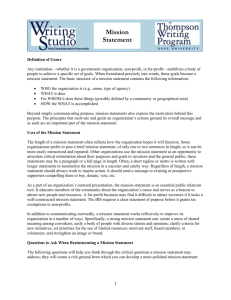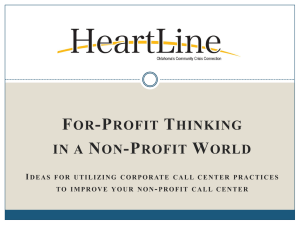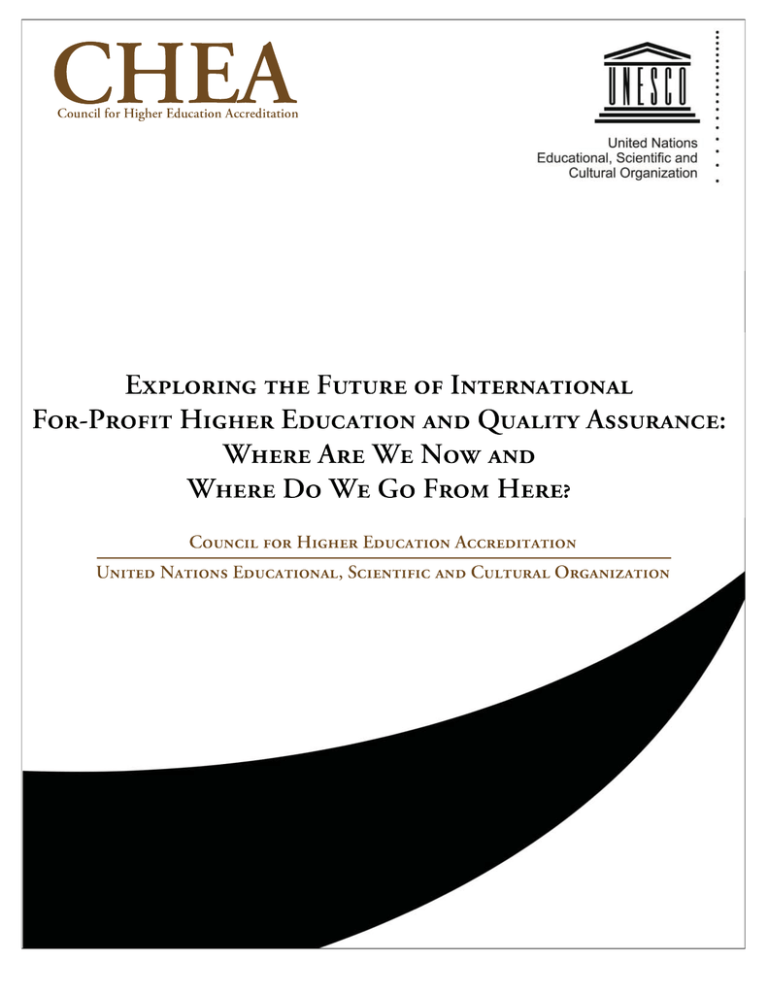
© Copyright 2011 Council for Higher Education Accreditation and United Nations
Educational, Scientific and Cultural Organization. All rights reserved. No part
of this publication may be reproduced or transmitted in any form or by any
means, electronic or mechanical, including photocopying, recording, or by any
information storage and retrieval system, without permission in writing from the
publisher.
EXPLORING THE FUTURE OF INTERNATIONAL FOR-PROFIT HIGHER
EDUCATION AND QUALITY ASSURANCE: WHERE ARE WE NOW
AND WHERE DO WE GO FROM HERE?
A CHEA – UNESCO MEETING
SUMMARY
March 21, 2011
Washington, DC
A meeting on for-profit higher education was convened on 21 March 2011 in Washington, DC by the
Council for Higher Education Accreditation (CHEA) and the United Nations Educational, Scientific and
Cultural Organization (UNESCO). It brought together some 25 participants representing executives of
for-profit colleges and universities, academic researchers who focus on this sector and accreditation and
quality assurance experts. The executives of for-profit universities and colleges were mainly from the
leading U.S. institutions such as Kaplan, Inc.,The University of Phoenix, Laureate Education and Career
Education Corporation. A representative of an Indian for-profit provider, NIIT (USA) Inc., attended the
meeting. Other participants included quality assurance agencies and academics from Egypt, Japan, the
United Arab Emirates, the United Kingdom, the United States, the International Finance Corporation and the
Commonwealth of Learning.
Purposes of the meeting
Following the various discussions of private and for-profit colleges and universities that occurred at
UNESCO’s 2009 World Conference on Higher Education, this meeting had three purposes:
1. To frame the emerging role of for-profit higher education as it relates to the international activity
of colleges, universities and quality assurance/accreditation organizations and, in particular, the
role that the for-profit sector plays in providing additional opportunity for those seeking higher
education. 2. To explore the feasibility of developing some common principles of accountability and
transparency across all higher education institutions nationally and internationally.
3. To prepare and publish a summary that provides a foundation for future consideration of
international for-profit higher education and provides background for a possible UNESCO Forum
on Private Higher Education to be held in 2012.
Exploring the Future of International For-Profit Higher Education and Quality Assurance
Page 1
The participants were provided with a wealth of literature published on for-profit higher education provision
which informed and enriched the debate. This was a significant opportunity to frame the emerging
international dialogue on the growth and impact of the for-profit sector. A key purpose was to discuss,
given recent news coverage of the for-profit sector in the United States, whether it was a problematic
element in the higher education system or made a useful contribution to increasing access.
UNESCO’s interest in private higher education provision had been heightened by the 2009 World
Conference on Higher Education, where it became clear that such provision would be important for
many of its 193 Member States as they struggled to meet increasing demand. Governments seek
UNESCO’s advice on the policies that they should adopt for integrating the private sector into their higher
education provision. There are parallels with earlier UNESCO work (with the Organisation for Economic
Cooperation and Development) on guidelines for quality assurance for cross-border higher education and
(with CHEA) on combating degree mills.
CHEA’s interest has been focused on creating connections between the for-profit and non-profit higher
education sectors in the United States, seeking benefit from the expanded access opportunities that are
made available while discouraging practices in both sectors that might prove problematic for students.
An important question is how the for-profit sector can be regulated without strangling it. Is it possible
to develop some common principles of accountability and transparency for all providers of higher
education? Although this meeting focused on the U.S. experience, future meetings will look at the reality
of for-profit higher education in other countries.
Models of for-profit higher education
Private higher education is a broad continuum of many types of providers. Although this meeting was
billed as being about for-profit providers, we must first ask if this distinction is helpful. All private providers
try to make a surplus and appear much the same on the ground, especially in developing countries.
A key issue is the business model used by the for-profit sector. The model created in the United States,
with investors seeking substantial financial returns, has raised many questions. However, taking an
international perspective, it may be that distinguishing within the private sector between for-profit and notfor-profit institutions is unhelpful. Public universities become profit-making enterprises when they operate
outside their home jurisdictions. In the Arab countries, governments are giving land to private institutions
because it is good for development.
Because developing countries have had to spend significant public resources on pursuing the United
Nations 2000 Millennium Development Goals in other areas, they have tended to give the market an
important role in higher education. A key task is to help governments see a positive role for the private
sector. Legitimate for-profit institutions welcome strong quality assurance frameworks, but ask that they
be applied fairly across the whole higher education sector.
Public institutions have to break even and re-invest any surpluses. The key question is what surpluses
are spent on. All public institutions are engaged in making cross-subsidies among units. However, the
private sector may be more disciplined about the way it reinvests surpluses. One reason advanced for the
success of the for-profit sector in the United States is that public institutions have priced themselves out
of the market and the for-profit higher education institutions have taken advantage of online technology to
drop prices.
The for-profit sector has been accused of questionable recruitment practices and low graduation
rates. Representatives of the sector from the United States said that they had improved in this regard,
beginning some years ago. This had resulted in significantly reduced recruitment by some institutions.
However, graduation rates are a difficult performance measure to apply because of student mobility
among institutions.
Page 2
CHEA • UNESCO
It is well known that students with prior experience do better, but students in the for-profit sector also tend
to come from lower socio-economic groups. The first-term drop-out rate is a big issue and, for this reason,
some institutions no longer operate open enrollment and do not collect the full fees at the beginning of the
course. However, standards are not being lowered in order to increase retention.
In the Middle East, rapidly increasing demand is driving the expansion of the private sector. Egypt
needs 100 new universities and student numbers will double by 2030. In the United Arab Emirates, the
proportion of students in private higher education institutions jumped from 23 percent to 60 percent just
this year.
A major Indian private institution works primarily through partnerships (e.g., with 180 universities in
China). In Africa, it has a partnership with a well-known UK university. Partner universities confer awards
based on the Indian institution’s courses and materials. In Africa, the cost of delivery is low and a blended
model is most successful.
The for-profit sector still faces problems in working in India, where the government has yet to put in place
a clear framework for private higher education.
The International Finance Corporation of the World Bank is encouraging the private sector in emerging
countries and would like to see more south-south investment in for-profit and nonprofit education.
Key issues for the international operations of for-profit higher education
There has been a major shift in perspective about international operations among the U.S. for-profits.
Models that have worked well in the United States have not always proved successful overseas and the
trend now is to undertake partnership arrangements and acquisitions in countries that are open to the
idea of for-profit education (e.g., Brazil, Spain). One for-profit company with institutions around the world
invests surpluses back in each country where they were earned, something that would be very difficult for
a public-sector institution.
Even in the United States, one size does not fit all – or at least not for long – since the profile of students
is constantly evolving. In one institution the typical student used to be a 35-year-old white middle
manager; now she is a 29-year-old African-American single mother. This has led institutions to gather
much better information about their students and to adjust the academic model to the student. The
business model is then adjusted to the academic model.
For-profit higher education companies can secure useful synergy between their operations in different
countries. Good curriculum costs money and these companies can invest in programmes and e-learning
platforms for the benefit of all their institutions. They can also centralise the oversight of compliance with
local regulations, which would be simpler if regulations were more consistent from country to country.
While buying institutions may be a good policy, it is not easy. There used to be a good number of family
institutions where the owners wanted to cash in, but a new approach may now be needed. It is good
practice to build teams of local people to run institutions rather than sending people in from overseas.
For-profits and online teaching
The for-profit sector has had considerable success with online teaching, partly because it is questionable
whether public-sector higher education institutions are really committed to reach out in this way. Often
students in public institutions are simply taking online courses in their dormitory rooms.
The for-profit sector tries to use the Internet to make education relevant by reflecting the way that the
Internet is used in contemporary life more generally. The sector is sceptical about adding too many ‘bells
and whistles’ to online teaching – do they really add value? The principle should be to use people when
students want to interact with people, and to use technology when they do not. Many students want to
blend human contact with online work. The for-profit sector does online teaching better because it has
Exploring the Future of International For-Profit Higher Education and Quality Assurance
Page 3
capital to invest, whereas the “lone-ranger” approach often used in public-sector institutions cannot be
scaled up.
The President of the United States’ goals for expanding higher education in the United States cannot be
achieved without recourse to online education and the same is true in Asia. Although the United States
has a high participation rate in higher education, there are still 80 million Americans without college
degrees and 30 percent of the population has never taken any college course.
Scholarly perspectives on for-profit provision
Scholars writing in this area note that public-private distinctions are blurred and become even fuzzier
when the cross-border dimension is added. There are no real international regulatory frameworks and,
in any case, many institutions fall outside national definitions of the tertiary education sector. Around the
world, much of the private sector is truly indigenous.
The private sector must charge fees and its students should be eligible for government subsidies. The
for-profit sector helps to address the access challenge and, at least in the United States, helps to create
demand. The key question students ask is whether study will be useful to them in getting employment.
For-profit higher education may prove to be a disruptive technology from both an academic and a
business perspective. Will it supplant traditional public-sector approaches? Government policy is still
trying to catch up with this unanticipated phenomenon.
Quality assurance, regulation, accreditation and disclosure
General issues
Quality assurance is a relatively recent concern in higher education in some countries. The issue
is whether public and for-profit institutions should be treated the same for the purposes of assuring
quality. Is the distinction between good and bad simply the dichotomy of corporate or public ownership?
Ownership is important for the tax authorities but is not, in principle, relevant to quality. There are good
and bad actors in the public sector and there should be the same quality thresholds for all.
Legitimate areas for regulation are the avoidance of excessive student loans, ground rules for acquiring
accredited institutions and processes for eliminating bad actors. The main plea is for a level playing
field. Any good institution starts with the student and builds a business model from there in a transparent
fashion.
Qualifications frameworks and minimum standards, as well as common requirements for transparency,
are helpful. If student employment outcomes are to be a criterion for quality judgments, they should be
applied to all institutions. However, not all countries can afford a sophisticated quality assurance agency.
But progress is being made. A UNESCO-CEPES study in Europe had looked at private higher education
institutions in 13 countries and found that, to a large extent, the same standards of quality assurance,
monitoring and access to research support were being applied. Nevertheless, the plea for a level playing
field can run up against immigration issues because there is a perception in some countries that the forprofit sector is helping people to circumvent immigration policies in a way that the public sector is not.
For-profit institutions are to provide information that accreditation requires and, as they internationalize,
they are dealing with accreditation bodies in other countries. They consider it in their interest to make
data about their operations public. They point out, however, that public higher education institutions have
prevented the disclosure of accreditation reports.
Scholars observe, however, that for-profits are less forthcoming on their Websites and less likely to
respond to requests for research data unless it is legally required.
Page 4
CHEA • UNESCO
Middle East and Arab Region
In the Middle East, one country checks an overseas institution’s intentions for its activities against its
mission statement for its home country when reviewing its application to operate. Sometimes incoming
institutions do not give faculty any role in governance and show little understanding of the local context.
Curricula tend to focus on business, with some engineering. Admission requirements are often set below
what would be required at home (e.g., in Australia, India or the UK), there is little student support and the
faculty are frequently poorly trained or briefed for their role and are given no opportunities for professional
development or research.
In the Arab region, all external quality assurance agencies now follow European, UK or U.S. methods and
there really is a common quality assurance language. With many joint degrees and much franchising,
international collaboration on quality assurance is a necessity. Open and distance learning is still a
challenge as is the multiplication of overseas campuses, which makes conducting quality assurance from
the home country more difficult. With many countries seeking to become education hubs, the number of
these campuses may continue to increase.
There is a danger that when institutions seek foreign accreditation, local and national needs can be
downplayed. There is also recourse to accreditation mills by some would-be providers in Arab countries.
United States
In the United States, there are essentially three types of for-profit providers: family-owned operations;
publicly traded companies and investor-owned institutions. Owners seeking accreditation tend to relax
day-to-day control although, in the case of religious orders, distinguishing between the institution and
the owner can be difficult. Public disclosure is sometimes a challenge for for-profit institutions outside of
meeting government requirements. The regulatory situation in the United States is complicated and often
difficult to understand. Some state regulation is designed to protect public institutions. It is sometimes
easier for a U.S. institution to go and operate in Europe than to cross state lines within country.
United Kingdom
The UK is liberal about foreign providers – the key proviso is that they obey the law. However,
understanding of the for-profit sector is still low. The UK Quality Assurance Agency (QAA) treats everyone
the same in reviewing applications for degree-awarding powers, but for-profit providers must have their
licences renewed every six years. UK higher education institutions must respect the QAA frameworks
wherever they operate and the QAA observes a ramping up of regulatory frameworks covering forprofit providers in developing countries. This is done with the aim of protecting both students and the
reputations of national higher education systems.
There is a huge number of tiny for-profits in the UK and the regulation of this sector is driven by the UK
Borders Agency rather than the QAA. One source of tension is that private institutions do not have to
supply the same information to the Higher Education Statistics Agency as the public higher education
institutions have to provide – even for their private students. Greater transparency in this regard would
help to dispel myths.
There are 420,000 people outside the UK taking UK degrees through various arrangements in 100
countries and, as more countries attempt to regulate cross-border education, some broadly shared
principles would be helpful.
The way forward: issues to note and pursue
The following issues were flagged:
•
There is a large unmet demand for higher education in many countries. For-profit institutions
have an important role to play in meeting it and in advancing the reform of higher education.
Exploring the Future of International For-Profit Higher Education and Quality Assurance
Page 5
•
Following controversy in recent years, the United States for-profit sector has modified its
practices, with education models now driving business models instead of the other way around.
•
Exporting a national model does not work as well as partnering with indigenous institutions to
strengthen their operations. Public-private partnerships can also be very productive.
•
Governments are increasingly focused on outcomes as well as access to higher education,
although defining longer-term outcomes is a challenge.
•
It is important to distinguish clearly between ownership, management and academic operations.
•
Governments need to learn more about for-profit provision. They expect providers to respond to
country needs and observe national norms. It is reasonable for governments to apply the same
standards of transparency and disclosure to all higher education institutions. The for-profit sector
accepts reasonable regulation of its activities.
•
There must be a balanced dialogue between for-profit providers and governments that focuses
on student outcomes and seeks to foster an indigenous private sector. There are now more
resources for governments to draw on in doing this and the notion of partnerships is gaining
increasing acceptance.
•
There is increasing acceptance of online education but, since distance learning is evolving
rapidly, quality assurance arrangements should remain flexible.
•
If quality assurance is partly about risk, are for-profit institutions inherently more risky than public
institutions?
•
International work in support of higher education is having a helpful impact on these issues, as
evidenced, for example, by the use of the UNESCO/OECD Guidelines for Quality Provision in
Cross-Border Higher Education.
Conclusions
The discussion showed that the for-profit sector can deliver education in the public interest. Accreditation
and quality assurance are important services to the public and are helping to make governments more
comfortable with a variety of business models in higher education. It is important to pursue the dialogue
about for-profit education within the academy as well as with governments. This will help to build bridges
and increase trust.
Sir John Daniel
Rapporteur
Page 6
CHEA • UNESCO
Exploring the Future of International For-Profit Higher Education and Quality Assurance
Page 7
Page 8
CHEA • UNESCO
CHEA
Council for Higher Education Accreditation
One Dupont Circle NW • Suite 510
Washington DC 20036-1135
tel: 202-955-6126
fax: 202-955-6129
email: chea@chea.org • www.chea.org
UNESCO
United Nations Educational,
Scientific and Cultural Organization
7, Place De Fontenoy
75352 Paris 07 SP France
tel: +33 (0) 1 45 68 10 00 • fax: +33 (0) 1 45 67 16 90
email: bpi@unesco.org • www.unesco.org

